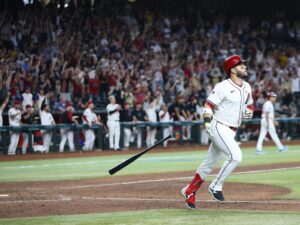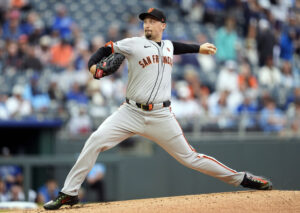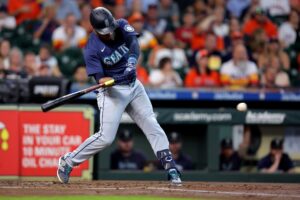With another World Series upon us, one wonders whether older baseball fans are thinking about Roberto Clemente and Frank Robinson. You’re already aware that the 2024 World Series will be a showcase of superstars on opposite teams. For the Los Angeles Dodgers, all their $700 million man Shohei Ohtani did was hit .310/.390/.646, 54 HR, 130 RBI, 190 OPS+, and 181 wRC+ while stealing 59 bases to become baseball’s first 50/50 man. Meanwhile, Aaron Judge of the New York Yankees hit .322/.458/.701, 58 HR, 144 RBI, 223 OPS+, and 218 wRC+. This, after hitting an American League record 62 home runs in 2022.
Aaron Judge. Shohei Ohtani.
Two of baseball’s biggest stars will meet on the #WorldSeries stage. Who will emerge victorious? pic.twitter.com/8EVKynJZDX
— MLB (@MLB) October 21, 2024
Ohtani/Judge World Series Recalls Clemente, Robinson, and 1971
The 1971 World Series featured two superstars of similar high caliber. Both were right fielders: Clemente of the Pittsburgh Pirates and Robinson of the Baltimore Orioles. Each was named the right fielder on the 1971 All-Major League Team poll conducted by the Newspaper Enterprise Association, Clemente for the National League, Robinson for the AL. They were older but still at the top of their game. Clemente, 37, hit .341/.370/.502, 13 HR, and 86 RBI in 1971. The following season would be his 18th and last due to his tragic death on New Year’s Eve 1972. His lifetime stat line of .317/.359/.475, 3,000 hits, 240 HR, and 1,305 RBI, along with his 12 Gold Glove Awards, would propel him into the Hall of Fame posthumously.
Robinson, 36, hit .281/.384/.510, 28 HR, and 99 RBI in 1971 and is also enshrined in the Hall of Fame. His career power numbers are astonishing, considering the era in which he played. For his 21-year career, he hit .294/.389/.537, 586 HR, and 1,812 RBI. Yet, Robinson’s name is strangely absent when the discussion turns to the game’s all-time greats. Maybe it’s because he’s not identified with one team, having been traded four times, never for equal value. In fact, the Orioles traded Robinson after that 1971 season so that they could hand right field to Merv Rettenmund, who hit .318 in 1971.
The Orioles had won the 1970 Series and were heavily favored to repeat. In the 1971 Series, Clemente was 12-for-29, with two doubles, a triple, two home runs, and a potential third home run that was ruled foul in Game 4, while Robinson was a none-too-shabby 7-for-25 with two homers of his own.
A Fiery Competitor
For Pittsburgh fans who didn’t remember Robinson’s competitive nature from his time with the Cincinnati Reds, they were quickly reminded. In Game 3 at Pittsburgh’s Three Rivers Stadium, won by the Pirates, 5-1, Robinson had two of the Orioles’ three hits against Steve Blass, one of them a home run. (Blass pitched complete game victories in Games 3 and 7. His .119 is the lowest opponents’ batting average in World Series history for pitchers with at least 18 innings pitched.)
The Pirates evened the Series in Game 4, thanks to the long-relief work of fearless rookie Bruce Kison. Kison plunked three Baltimore batters, citing wildness rather than intent. The Orioles took his word for it. They were less charitable in discussing Kison running into second base standing up in the fourth inning, colliding with second baseman Davey Johnson to break up a double play. (Both lost their caps, Kison comically putting on Johnson’s by mistake.) Robinson angrily told Roy McHugh of The Pittsburgh Press, “If I had been playing second, [Kison] wouldn’t have been able to walk back to the mound.”
After Nelson Briles’ two-hit shutout in Game 5 put Pittsburgh ahead in the Series, 3-2, Orioles manager Earl Weaver tried to light a fire under his right fielder, as if one weren’t already smoldering. “Frank looked like he was going to win the automobile until yesterday,” Weaver told Vince Leonard of the Pittsburgh Post-Gazette. Leonard wrote that Robinson’s “deportment smacked of not caring so much” about the World Series Most Valuable Player Award.
The “Coal Hole”
Meanwhile, Clemente was happy to see the World Series shift to Three Rivers Stadium and its artificial surface. Of Baltimore’s Memorial Stadium, he told Charley Feeney of the Post-Gazette, “I played in all kinds of fields in bare feet when I was a boy in Puerto Rico. I know what a bad field is. In Baltimore, it’s difficult to charge the ball because of those bad spots in the outfield.”
According to Feeney and McHugh, Robinson replied, “Clemente played for 18 years in a coal hole,” referencing Forbes Field. (There was more than a grain of truth in Robinson’s description of the venerable old ballpark. But Clemente played 15 ½ seasons there, not 18.) “If he’s all that great an outfielder,” Robinson continued, “he should be able to adjust. If he can’t adjust, tell him to watch the way I play right field – or buy a ticket and sit in the stands.”
Pressed by Feeney, Clemente elaborated, “It’s not a major league park in Baltimore. They say the outfield is torn up because of the football games there. It’s not only the bad bounces. When you run in the outfield, you hit a large piece of grass, then dirt, then maybe a small hole. You can’t see the ball come off the bat. It’s just a bad park.”
Yet Clemente wouldn’t get drawn into a cold war with Robinson. “If Frank Robinson is a better ballplayer than I am, he can say what he want[s] to,” Clemente told the assembled media. “You think you can get me into a fight with Frank Robinson.” Clemente was too smart for that.
“I Was a Far Better Manager”
Al Abrams was a sportswriter for the Post-Gazette from 1926-77, serving as sports editor from 1947-74. In his book Double Yoi!, Myron Cope wrote, “Al had absolutely no talent for writing, but was smart enough to know it.” According to Cope, Abrams often took a column from an out-of-town newspaper, rearranged and reworded it, and published it as his work. “Technology had not shrunk the world, transmitting printed matter across the internet,” wrote Cope, “so believe it or not, as far as I know, Al Abram’s plagiarisms were never found out.” Yet Abram’s “Sidelights on Sports” column was an essential, popular feature that Pittsburgh eagerly read each morning with breakfast. Often, it was a highly readable series of unrelated statements and random thoughts separated by ellipses.
Buried among other thoughts in Abram’s column of Saturday, October 16, the day of Game 6, displaying his fondness for colons, was this: “Added fuel to the Roberto Clemente-Frank Robinson feud: Robinson told me: ‘I was a far better manager than he was in the Puerto Rican Winter League.’ . . .” It was as if Robinson were inventing trolling, some 33 years before the advent of Facebook. There is no record of Clemente being asked to rebut Robinson’s charge. (In the majors, Robinson managed five teams from 1977-2006, with gaps. His record was 1,065-1,176. In the 16 seasons he managed, his teams finished as high as second just twice. He was often criticized for expecting his players to play as well as he had, as if it were that easy.)
Clemente’s One-Man Show Falls Short
As the scene shifted back to Memorial Stadium, Clemente did his best to win Game 6 for the Pirates. In the top of the first inning, he hit a long fly that one-hopped the left field wall. Orioles left fielder Don Buford retrieved it quickly and got it to shortstop Mark Belanger, but the speedy Clemente beat the off-target relay throw to third base for a two-out triple. Alas, he was stranded there when Willie Stargell struck out. In the third inning, Clemente lined an outside pitch from Jim Palmer into the right-field stands as Robinson helplessly watched it sail over his head. The solo shot put the Pirates ahead, 2-0.
Robinson’s Speed Wins Game 6
Baltimore came back to tie it and sent the game to extra innings. In the bottom of the 10th, Robinson drew a one-out walk against Pirates pitcher Bob Miller. Although Robinson was hitless on the day, he showed that he could still win a game with speed and savvy. Veteran Vic Davalillo had just entered the game in center field as part of a double switch. (Kids who grew up knowing only the designated hitter: Ask your parents.) The speedy Davalillo had won a Gold Glove Award in 1964 as the center fielder of the Cleveland Indians. However, Robinson knew Davalillo lacked a strong throwing arm.
Rettenmund followed with a ground-ball single to center field. Robinson, bothered by a tight Achilles tendon for much of 1971, scooted into third ahead of Davalillo’s throw. Third base coach Billy Hunter asked Robinson if Weaver should send in Paul Blair to run for him. Robinson declined. The next batter, Brooks Robinson, hit a fly ball gloved by Davalillo in shallow center field. Frank Robinson gambled and took off for the plate. Davalillo’s weak, one-hop throw took a high bounce. As catcher Manny Sanguillén leaped for the throw, the wily veteran slid underneath him to score the winning run.
Taxi Driver
The next morning, Clemente and Sanguillén climbed into a taxicab. The driver asked whether they were headed to Memorial Stadium for Game 7. They simply said, yes, they were. The driver, unaware of who his passengers were, began to berate Clemente. He thought Robinson was the better player and Clemente was just a whiner. The famous passengers just listened, wordlessly. When they arrived at their destination, Clemente identified himself to the flabbergasted driver, told him how he would be pitched by Orioles pitcher Mike Cuellar, and predicted he’d hit a home run off the left-hander. Clemente said he needed his first at-bat to time Cuellar and would hit the homer the second time around.
Clemente stepped up to bat in the fourth inning of the scoreless game after grounding out in his first trip. Cuellar tried to flop a slow curveball over the plate. Maybe it was supposed to be his screwball. True to his word, Clemente belted a long home run over the left-center field wall. The Pirates went on to win Game 7, 2-1. Frank Robinson, competitive to the end, maintained that the better team had lost.
MVP
Clemente would be named the Series MVP. In his book, A Pirate For Life, Blass addressed the issue of whether he thought he had a chance to be the Series MVP. “Yes, I do,” wrote Blass. “But that was Roberto Clemente’s World Series, and I had no qualms about him winning it. That was his show, and I was thrilled that everyone else could see what we had been seeing for all those years.”
The Last Word
The 2024 World Series, which begins on Friday, should be interesting. As noted, it will match two superstars in Ohtani and Judge. It will also be a sad reminder of the unfair economics of baseball. These two talent-laden teams were virtually predestined to face one another in the end. The regular season and postseason leading up to it were merely ceremonial.
However, it should be fun for the baseball fan who can set those feelings aside. It took the Yankees five games to win the AL Championship Series, while the Dodgers won the NLCS in six games. Thus, both can set up their pitching any way they wish. Two great teams will be on equal footing.
It’s unlikely that Ohtani and Judge will clash verbally as Clemente and Robinson did. Due to the language barrier, Ohtani does most of his talking with his bat and (when healthy) arm. Judge comes across as a genuinely nice person. But given their large-market advantages, the Dodgers and Yankees might have sustained success for a few years yet. If so, Ohtani/Judge may one day be thought of as the baseball equivalent of Larry Bird/Magic Johnson.






